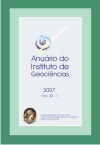Influence of the environmental factors in preservation of the benthic foraminifera microfauna in the Parrachos de Maracajaú reef environment, RN, Brazil
DOI:
https://doi.org/10.11137/2007_2_92-103Abstract
Taphonomy focuses on the post-mortem processes of transport and preservation of biotic remains in the sedimentary record, and as such it has important applications for paleoenvironmental reconstructions. The aim of this work is to verify the degree of dissolution, abrasion, bioerosion and fragmentation in foraminiferal tests recovered from bottom sediments of the Parrachos de Maracajaú, Rio Grande do Norte, and to estimate the influence of these taphonomic processes in the distributon and preservation of the assemblages. Fifty-one species of benthic foraminifera have been found in the studied site. The taxonomic composition is typical of a coral reef environment. Amphistegina lessoni, Sorites marginalis, Quinqueloculina lamarckiana, Q. agglutinans, Peneroplis carinatus and Archaias angulatus are abundant in all the studied localities. The energy of the environment was interpreted as high. The species have been grouped into two groups, and the statistical data show that all four taphonomic processes (dissolution, abrasion, bioerosion and fragmentation) have influenced the distribution and preservation patterns of the foraminifera.Downloads
Download data is not yet available.
Downloads
Published
2007-12-01
How to Cite
Batista, D. S., Vilela, C. G. and Koutsoukos, E. A. M. (2007) “Influence of the environmental factors in preservation of the benthic foraminifera microfauna in the Parrachos de Maracajaú reef environment, RN, Brazil”, Anuário do Instituto de Geociências. Rio de Janeiro, BR, 30(2), pp. 92–103. doi: 10.11137/2007_2_92-103.
Issue
Section
não definida
License
This journal is licensed under a Creative Commons — Attribution 4.0 International — CC BY 4.0, which permits use, distribution and reproduction in any medium, provided the original work is properly cited.















